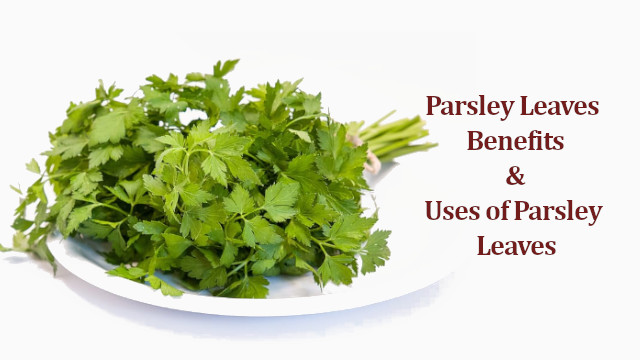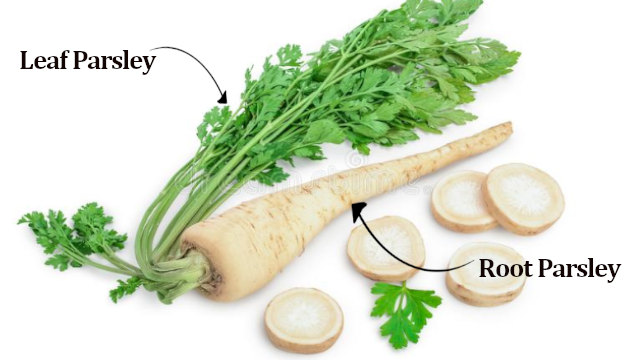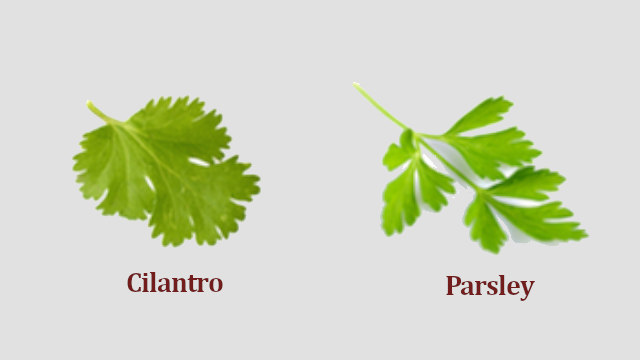Parsley Leaves Benefits and Uses of Parsley Leaves

Looking for parsley leaves benefits? Parsley leaves need no introduction as it is a popular herb used for many years to give our favorite dishes a complete look. But garnishing and seasoning food is not the only reason this herb is so famous worldwide. Its numerous health benefits that we can obtain from these tiny green leaves.
So to explore the usefulness of parsley leaves, other than garnishing, we are trying to discover the unknown facts about parsley. I am sure this article will help you think about its benefits in a new way. Let us see Parsley Leaves benefits and uses of parsley leaves.
In This Article
- What Type of Plant is Parsley
- Difference Between Cilantro and Parsley Leaves
- Parsley Nutrition Facts
- Benefits and Uses of Parsley Leaves
- How to Make Parsley Juice in a blender
- Side Effects of Parsley Leaves
What Type of Plant is Parsley
This tiny biennial plant is native to the Mediterranean region, i.e., Greece, Italy, Spain, and Tunisia. Later on, acclaimed in other European countries and widely cultivated on seasoning herbs to enhance the flavor of any dish.
It needs a moist climate and enough sunlight to grow, and it takes a long time to germinate from the seed. The two main groups of parsley are:

Leaf Parsley
Mainly flat leaf and curly leaf— these two varieties are popular. Flat-leaved parsley is used for cooking, while the curly leaf is preferred for garnishing because of its beautiful looks.
Root Parsley
This verity consists of a thick root, and it is popular in European cuisine, especially in soups and stews. It’s almost similar to a carrot.
Difference Between Cilantro and Parsley Leaves

Cilantro (coriander) is often used interchangeably with parsley, which is confusing.
Cilantro and parsley are often confused since there are similarities between their appearances and uses.
They are members of the same family, which also includes carrots and celery among its members.
Parsley and cilantro, however, are two very different plants with subtle variations in appearance, taste, and culinary use.
Parsley Nutrition Facts
Petroselinum cripsum, or parsley, whatever you call it, is a unique herb with culinary and medical uses.
It hosts many antioxidants and flavinoids, among which luteolin, apigenin folic acids, vitamin K, vitamin C, and vitamin A are worth mentioning.
If we consume a half tablespoon of dried parsley, the amount of nutrition we will get is as follows.
- 6.0 mcg of lycopene.
- 82.9 mcg of lutein and zeaxanthin.
- 10.7 mcg of alpha-carotene.
- 80.7 mcg of bête carotene.
Specific volatile components like myristicin, eugenol, and alpha-thujene are found in parsley.
Benefits and Uses of Parsley Leaves
Here is the list of parsley leaf benefits
1. Ward off Morning Breath
Foul breath caused by the bacteria which build from food residue and low rate of saliva production is one of the awkward situations we face every morning.
To get rid of this embarrassing condition, we can take the help of parsley leaves. Parsley has an antibacterial property that prevents the formation of bacteria, and thus it is a mouth freshener.
So including chopped parsley with salad or chewing parsley spring daily will be helpful enough to eliminate foul odor.
2. Clean Our Kidney
Parsley is best known for its use as a diuretic drug. Parsley juice parsley teas detoxify our body and clean the kidney. Thus it boosts kidney function.
The kidney is one of the most important organs that purify the blood by eradicating unwanted waste. So if our kidney fails to work correctly, we feel sick due to the toxin deposited in the blood.
So we must include medicinal herbs like parsley in our diet to keep ourselves healthy and fit. Being a storehouse of antioxidants and vitamins, parsley can naturally clean the kidney.
Apart from this, it is an essential diuretic drug that can cure kidney stones.
Also Read: Surprising Benefits of Drinking Moringa
3. Aids in Weight Loss
Parsley influence weight loss. It is a nutrient-enriched herb, and at the same time, its calorie content is very low.
So there is no chance of gaining weight if we consume it daily. Moreover, it improves metabolism. Ten sprigs of parsley provide with us —
- 1gm fat.
- 1gm sugar.
- 6gm carbohydrates.
So adding it to our daily diet will help us gain essential nutrition with increasing weight.
4. Boost up Immunity
Strong immunity power is the secret to healthy living and fitness. We all are born with immunity power that protects us from illness. Foods that we taste daily play a vital role in building immunity.
Anyone with a strong immunity power can easily defeat any outer infection.
Herbs like parsley contain many vitamins, minerals, and antioxidants that boost the power to combat viruses and bacteria that causes fever, cold, cough, etc.
The main vitamin content that helps in this matter are vitamins C, A, and K.
5. Prevent the Risk of Cancer
Flavonoids, the primary antioxidants present in moderate quantities in parsley, help prevent cancerous growth. It also has Myricetin, which works best to act in the prevention of skin cancer.
It can inhibit cancer-causing reagents known as Heterocyclic Amines or HCAs. These HCAs form when any meat is grilled or cooked using a direct open flame.
So it is recommended for grilled meat lovers to take parsley salad as a side dish to reduce the harmful effects.
Besides this, Apigenin, also a flavinoid, stops a cancerous tumor from spreading further by preventing the secretion of cancer-influencing enzymes.
6. Beneficial for Skin and Hair Health
We can get Parsley leaves benefits for improving skin and hair health. Let us see how.
Hair care:
The paste of parsley seed is beneficial in reducing hair problems like dandruff, head lice, etc. it also soothes the itching cap to a great extent.
By applying the parsley seed paste, we can make our hair follicles strong enough and thus reduce hair fall.
Skin Care:
Unlike hair application, parsley leaves paste is equally beneficial as a face mask to remove acne, pimple, and wrinkles.
Besides the external application, taking parsley juice or leaves in green salads may be helpful for skin health as it contains Beta Carotene, which converts into vitamin A and improves skin health.
7. Relief from Joint pain
Parsley leaves are a well-known home remedy for those who have arthritis. It can give relief if applied to the affected area.
The presence of vitamin k, vitamin c, and Beta-carotene instantly slows down the pain and redness of the swelling joints.
To apply calmly, all you need is some fresh parsley leaves. Crush them and apply them to the area. You can also cover it with a bandage.
8. Improve Vision with Parsley
Eye health is as much important as far as our well-being is concerned. Parsley is vital in improving eye health as it is green and contains antioxidants and vitamins like A.
The presence of carotenoid and beta-carotene prevents the eye cell from damaging and delaying the formation of cataracts. It also resists under-eye bags and dark circles.
Check out this article, too: coriander seed water for thyroid
9. Raise Haemoglobin
Parsley leaves have a high density of iron (almost 6.2mg/100 gm), with other minerals and vitamins that help to absorb iron from foods.
So including parsley in salads or smoothies can be helpful to raise hemoglobin levels in the blood, unless anemia may occur.
Related: 10 Best Home Remedies for Anemia
10. Helps to Manage Indigestion
Lack of proper digestion is the root of physical uncomfortable and flatulence.
The quantity of fiber and enzymes in parsley leaves helps digest foods like protein and fat.
How to Make Parsley Juice in a blender
To take Parsley juice is a great way to get all the benefits as insoluble condition our body can absorb all the nutrients efficiently. Now here is a step-by-step follow-up of the procedure.
The Ingredients are:
- A bunch of fresh parsley.
- One lemon.
- One tablespoon of honey.
- One tablespoon of ginger root.
- One Green Apple.
Method:
- Wash all the ingredients.
- Grate the apple.
- Squeeze the lemon juice.
- Cut the ginger into a slice.
- Put all the ingredients into a mixer grinder with one cup of water.
- Grind them well until you get the juice.
- If you want to apply it to detox your body, mix grated cucumber with it.
- The juice is full of all the nutrients and fiber and is easily digestible.
Side Effects of Parsley Leaves
Overconsumption of anything creates adverse effects, and Parsley is not an exception. Excess use can cause side effects in the following cases:
1): Pregnancy: a pregnant woman should not take an excessive quantity of parsley as it can cause a contraction in the uterus.
2): Those suffering from gouts should take it in low amounts as parsley contains a high amount of oxalate, which is harmful to them.
3): Allergies: Those with sensitive skin must be careful before consuming it.
4): Anyone taking blood-thinning drugs must be cautious before consuming them in excess quantity as it contains vitamin K, which tends to clot the blood.
At the end of the discussion, we can say that parsley can serve a significant role in keeping you healthy if you include it in your daily food.
You can take it with salad; garnish the mixed veg curries with egg dishes and other dishes, but always in a moderate quantity. The health benefits that it can offer are nothing but nature’s blessing for all of us.
References
- Antioxidant Potential of Parsley Leaf
- Effect of fortification with parsley
- Effects of Parsley and Coriander leaves on hypercholesterolemic rats





